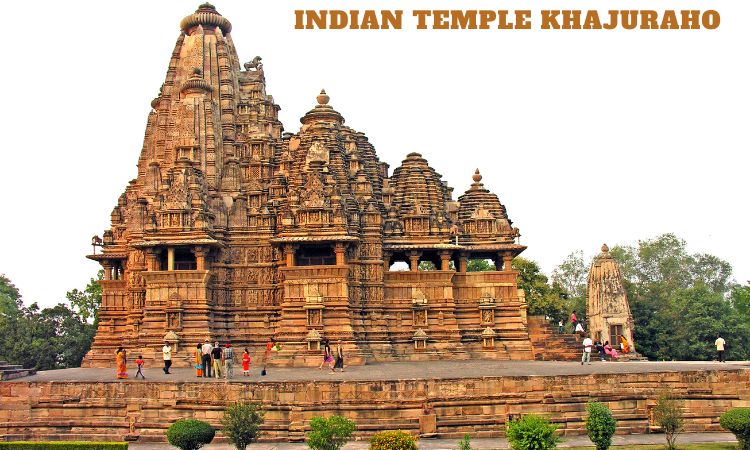
Table of Contents
The Indian Temple Khajuraho stands as a monumental tribute to India’s deep-rooted cultural, spiritual, and architectural legacy. Nestled in the heart of Madhya Pradesh, this UNESCO World Heritage Site draws global attention for its awe-inspiring sculptures, intricate carvings, and symbolic erotic art. Constructed between 950 and 1050 AD by the Chandela dynasty, the Khajuraho temples are among the most iconic and artistically valuable structures in India.
The Historical Significance of Indian Temple Khajuraho
The Khajuraho temples were originally a collection of over 85 temples, of which only 22 remain today. These temples were commissioned under the rule of the Chandela kings, a dynasty known for promoting art, dance, music, and architecture. The temples were largely forgotten and engulfed by the forests until rediscovered by British engineer T.S. Burt in 1838.
These temples depict an era of prosperity, liberal thinking, and artistic freedom. The walls of the temples illustrate various aspects of life, including daily routines, mythical tales, spiritual teachings, and erotic expressions—a celebration of the physical and the metaphysical.
Architectural Brilliance of Khajuraho Temples
The Indian Temple Khajuraho represents the zenith of Nagara-style architecture, characterized by lofty towers (shikharas), intricate ornamentation, and a sanctum (garbhagriha) at the core. Each temple follows a well-thought-out layout, leading the devotee from the outer entrance into deeper spiritual sanctums.
-
Material Used: Most temples were constructed using sandstone, giving them a durable yet elegant finish.
-
Design Philosophy: The architecture follows the Vastu-Purusha-Mandala, reflecting harmony between cosmic energy and human activity.
-
Symbolism: Every sculpture, from gods and goddesses to dancers and mythical beasts, plays a symbolic role representing life’s complexity.
Erotic Sculptures – Misunderstood Masterpieces
Perhaps the most discussed feature of the Indian Temple Khajuraho is its erotic carvings, which make up about 10% of the temple art. These sculptures are not merely titillating visuals but are deeply symbolic, representing:
-
The Tantric philosophy that sexuality is a pathway to spiritual liberation.
-
The holistic view of life—acknowledging the material, emotional, and spiritual dimensions.
-
Cultural narratives, reflecting the openness of Indian society during that era.
These carvings are sensual yet tasteful, integrated harmoniously into the temple walls without being overwhelming.
Main Temples You Must Visit at Khajuraho
The Khajuraho temple complex is broadly divided into three zones: Western, Eastern, and Southern.
Western Group of Temples
-
Kandariya Mahadev Temple: The largest and most ornate temple, dedicated to Lord Shiva. Its shikhara rises 31 meters high.
-
Lakshmana Temple: Known for its architectural symmetry and fine sculpture of Vaikuntha Vishnu.
-
Vishwanatha Temple: Features captivating sculptures of guardians and celestial beings.
Eastern Group of Temples
-
Parsvanatha Temple: A Jain temple that displays both Jain and Hindu influences.
-
Adinatha Temple: Dedicated to the first Jain Tirthankara, with exquisite carvings of dancers and musicians.
Southern Group of Temples
-
Duladeo Temple: Dedicated to Shiva, showcasing intricate celestial nymph carvings.
-
Chaturbhuja Temple: Uniquely features a four-armed Vishnu idol, without any erotic sculptures.
Khajuraho Dance Festival – A Cultural Extravaganza
Every February, the Khajuraho Dance Festival brings the stone carvings to life through classical dance forms like Bharatanatyam, Kathak, Odissi, and Kuchipudi. Set against the illuminated backdrop of the temples, this festival is a mesmerizing celebration of India’s dance heritage, attracting performers and tourists from around the world.
Spiritual Essence Beyond Erotica
While the erotic art often captures headlines, the Indian Temple Khajuraho is deeply spiritual. Each temple is aligned to the cardinal directions and represents various Hindu deities like Shiva, Vishnu, and Surya, alongside Jain Tirthankaras. The placement of erotic sculptures on the outer walls may symbolize the journey from desire to enlightenment, as the inner sanctum remains spiritually pure and reserved for the deity.
UNESCO World Heritage Recognition
In 1986, the Khajuraho Group of Monuments was inscribed as a UNESCO World Heritage Site, affirming its outstanding universal value. The preservation of these temples reflects global recognition of India’s artistic, architectural, and philosophical contributions to world heritage.
Best Time to Visit Indian Temple Khajuraho
-
Ideal Season: October to March offers the best weather for exploring the temples.
-
Avoid Monsoons: The rainy season (July to September) can hinder outdoor activities.
-
Time of Day: Early mornings or late afternoons provide the best lighting for photography and a more serene experience.
How to Reach Khajuraho?
-
By Air: Khajuraho has a small airport with regular flights from Delhi and Varanasi.
-
By Train: Well-connected by rail to major cities like Jhansi, Bhopal, and Delhi.
-
By Road: Easily accessible via highways from Satna, Jhansi, and Bhopal.
Tips for Visitors
-
Guided Tours: Hire an ASI-approved guide for historical and cultural insights.
-
Respect the Sanctity: Dress modestly and avoid disruptive behavior.
-
Photography: Allowed in most areas, but flash should be avoided to preserve carvings.
-
Combine Your Trip: Pair your Khajuraho visit with nearby attractions like Panna National Park and Raneh Falls.
Khajuraho in Modern Times
Despite being centuries old, the Indian Temple Khajuraho continues to influence art, tourism, and academic discourse. It challenges modern notions of morality and spirituality, offering a nuanced view of human experience, rooted in ancient wisdom. Modern conservation efforts ensure that this treasure trove of Indian heritage remains intact for future generations.
Conclusion
The Indian Temple Khajuraho is not just a historical monument; it is a living embodiment of India’s pluralistic ethos, where art, faith, and sensuality converge harmoniously. Its temples stand as silent storytellers, whispering tales of ancient dynasties, divine passions, and spiritual journeys. A visit to Khajuraho is not merely a sightseeing trip—it is a pilgrimage into India’s rich and complex cultural soul.


